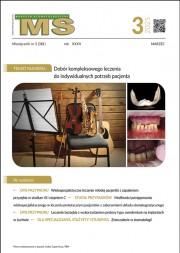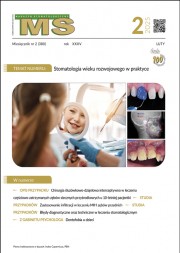Dostęp do tego artykułu jest płatny.
Zapraszamy do zakupu!
Po dokonaniu zakupu artykuł w postaci pliku PDF prześlemy bezpośrednio pod twój adres e-mail.
ARTYKUŁ PRZEGLĄDOWY
Powikłania związane ze stosowaniem kwasu hialuronowego w rejonie twarzy i warg w aspekcie stomatologicznym – przegląd narracyjny piśmiennictwa
Complications associated with the use of hyaluronic acid in the facial and lip region in the dental aspect – a narrative review of the literature
Amelia Rusiecka, Natalia Bielecka-Kowalska, Natalia Lewkowicz
Streszczenie
Rosnąca popularność zabiegów medycyny estetycznej w obrębie twarzy stawia przed lekarzami dentystami nowe wyzwania. Szczególną uwagę należy poświęcić zabiegom z wykorzystaniem wypełniaczy, często stosowanych w rejonie czerwieni warg, która stanowi bezpośrednią okolicę pola zabiegowego dla stomatologa. Najpopularniejsze na rynku preparaty stosowane jako wypełniacze zawierają kwas hialuronowy (HA). Jako najczęstsze powikłania po zastosowaniu kwasu hialuronowego w postaci iniekcji odnotowuje się miejscowy obrzęk, zasinienie lub zaczerwienienie, tkliwość oraz bolesność. Odnotowano przypadki, w których procedura powiększenia ust za pomocą kwasu hialuronowego doprowadziła do poważnych i długotrwałych powikłań. Podanie preparatów na bazie HA może być przyczyną rozwoju ziarniniaków oraz ropni w obrębie warg i okolicy nosowo-wargowej. Zdarza się również, że do zabiegów kosmetycznych stosuje się nieprawidłową technikę lub są przeprowadzane za pomocą preparatów złej jakości, co sprzyja wystąpieniu reakcji niepożądanych. W praktyce lekarza nieoceniona jest świadomość, jakie patologiczne zmiany mogą stanowić zagrożenie dla pacjenta, oraz umiejętność odróżnienia ich od objawów przemijających i często występujących w konsekwencji powiększania ust. Wiedza o powikłaniach może okazać się kluczowa w trakcie terapii oraz pozwala rozstrzygnąć, czy pojawiające się zmiany mogą być powiązane ze stanem jamy ustnej. Preparaty z HA są bezpieczne i biodegradowalne, lecz poza oczekiwanymi i obiecującymi efektami zabiegu mogą spowodować wiele reakcji niepożądanych. Celem pracy była analiza dostępnego piśmiennictwa z uwzględnieniem aspektów klinicznych istotnych dla praktyki dentystycznej. Przeprowadzono przegląd piśmiennictwa w języku polskim i angielskim z lat 2008-2022. Wykorzystano bazy PubMed, Medline i Web of Science.
Abstract
The growing popularity of facial aesthetic medicine procedures brings dentists new challenges. Particular attention should be paid to treatments with fillers, often used in the lip region, which is also an area of treatment for the dentist. The most popular preparations used as fillers in the market contain hyaluronic acid (HA). Local swelling, bruising or redness, tenderness and soreness are noted as the most common complications after hyaluronic acid injection. Cases have been reported where the procedure of lip augmentation with hyaluronic acid has led to serious and long-term complications. Administration of HA-based preparations can cause the development of granulomas and abscesses in the lips and nasolabial area. Cosmetic procedures were sometimes performed incorrectly or with poor-quality preparations, which promoted adverse reactions. In a clinician’s practice, it is invaluable to be aware of which pathological lesions may pose a risk to the patient, and to be able to distinguish them from the transient symptoms that commonly occur as a consequence of lip augmentation. Knowledge about potential complications may be crucial in the course of therapy, and will allow one to decide whether emerging lesions may be related to diseases of oral cavity. Although HA preparations are safe and biodegradable and usually giving predictable effects of the procedure, they can cause numerous adverse reactions. The purpose of this study was to analyze the available literature in respect to implications for daily dental practice. A review of the literature in Polish and English from 2008-2022 was carried out. PubMed, Medline and Web of Science databases were used.
Hasła indeksowe: kwas hialuronowy (HA), powikłania, medycyna estetyczna, stomatologia
Key words: hyaluronic acid (HA), complications, aesthetic medicine, dentistry
Piśmiennictwo
- Casale M, Moffa A, Vella P i wsp. Hyaluronic acid. Perspectives in dentistry. A systematic review. Int J Immunopathol Pharmacol. 2016; 29(4): 572-582.
- Gaweł-Maciejewska A, Bielecka-Kowalska N, Lewkowicz N. Kwas hialuronowy w leczeniu chorób przyzębia i błony śluzowej jamy ustnej. Przegląd piśmiennictwa. Mag. Stomatol. 2020; 1: 74-78.
- De Boulle K, Heydenrych I. Patient factors influencing dermal filler complications. Prevention, assessment, and treatment. Clin Cosmet Investig Dermatol. 2015; 8: 205-214.
- Urdiales-Gálvez F, Delgado NE, Figueiredo V i wsp. Treatment of soft tissue filler complications. Expert consensus recommendations. Aesthetic Plast Surg. 2018; 42(2): 498-510.
- Urdiales-Gálvez F, Delgado NE, Figueiredo V i wsp. Preventing the complications associated with the use of dermal fillers in facial aesthetic procedures. An expert group consensus report. Aesthetic Plast Surg. 2017; 41(3): 667-677.
- Narins RS, Coleman WP 3rd, Glogau RG. Recommendations and treatment options for nodules and other filler complications. Dermatol Surg. 2009; 35(suppl 2): 1667-1671.
- Lafaille P, Benedetto A. Fillers: contraindications, side effects and precautions. J Cutan Aesthet Surg. 2010; 3(1): 16-19.
- Stojanovič L, Majdič N. Effectiveness and safety of hyaluronic acid fillers used to enhance overall lip fullness. A systematic review of clinical studies. J Cosmet Dermatol. 2019; 18(2): 436-443.
- Marusza W, Mlynarczyk G, Olszanski R i wsp. Probable biofilm formation in the cheek as a complication of soft tissue filler resulting from improper endodontic treatment of tooth 16. Int J Nanomedicine. 2012; 7: 1441-1447.
- Berberi A, Hjeij B, Aad G i wsp. Infected facial tissue fillers caused by dental infection. Case Rep Dent. 2021; 2021: 8661995.
- Decates TS, Kruijt Spanjer EC, Saini R i wsp. Unilateral facial edema after filler injection of the lower eyelid. Dermatol Ther. 2020; 33(4): e13539.
- Ramzi AA, Kassim M, George JV i wsp. Dental procedures. Is it a risk factor for injectable dermal fillers? J Maxillofac Oral Surg. 2015; 14(suppl 1): 158-160.
- Funt D, Pavicic T. Dermal fillers in aesthetics. An overview of adverse events and treatment approaches. Clin Cosmet Investig Dermatol. 2013; 6: 295-316.
- Bitterman-Deutsch O, Kogan L, Nasser F. Delayed immune mediated adverse effects to hyaluronic acid fillers. Report of five cases and review of the literature. Dermatol Reports. 2015; 7(1): 5851.
- Alcântara CEP, Noronha MS, Cunha JF i wsp. Granulomatous reaction to hyaluronic acid filler material in oral and perioral region. A case report and review of literature. J Cosmet Dermatol. 2018; 17(4): 578-583.
- Abduljabbar MH, Basendwh MA. Complications of hyaluronic acid fillers and their managements. J Dermatology Dermatologic Surg. 2016; 20(2): 100-106.
- Dayan S, Bruce S, Kilmer S i wsp. Safety and effectiveness of the hyaluronic acid filler, HYC-24L, for lip and perioral augmentation. Dermatol Surg. 2015; 41(Suppl 1): S293-S301.
- Czumbel LM, Farkasdi S, Gede N i wsp. Hyaluronic acid is an effective dermal filler for lip augmentation. A meta-analysis. Front Surg. 2021; 8: 681028.
- Heim N, Faron A, Wiedemeyer V i wsp. Verzögerte infektion nach Augmentation der Oberlippe mit resorbierbarem Hyaluronsäurefiller (Delayed infection after upper lip augmentation with absorbable hyaluronic acid filler). Handchir Mikrochir Plast Chir. 2015; 47(4): 268-270.
- Diwan Z, Trikha S, Etemad-Shahidi S i wsp. Case series and review on managing abscesses secondary to hyaluronic acid soft tissue fillers with recommended management guidelines. J Clin Aesthet Dermatol. 2020; 13(11): 37-43.
- Kim JH, Ahn DK, Jeong HS i wsp. Treatment algorithm of complications after filler injection. Based on wound healing process. J Korean Med Sci. 2014; 29 Suppl 3(Suppl 3): S176-S182.
- Wehl G, Rauchenzauner M. A systematic review of the literature of the three related disease entities cheilitis granulomatosa, orofacial granulomatosis and Melkersson-Rosenthal syndrome. Curr Pediatr Rev. 2018; 14(3): 196-203.
- Molina-Ruiz AM, Requena L. Foreign body granulomas. Dermatol Clin. 2015; 33(3): 497-523.
- Trinh LN, McGuigan KC, Gupta A. Delayed granulomas as a complication secondary to lip augmentation with dermal fillers. A systematic review. Surg J (N Y). 2022; 8(1): e69-e79.
- Martin LHC, Hankinson PM, Khurram SA. Beauty is only mucosa deep. A retrospective analysis of oral lumps and bumps caused by cosmetic fillers. Br Dent J. 2019; 227(4): 281-284.
- Cassiano D, Miyuki Iida T, Lúcia Recio A i wsp. Delayed skin necrosis following hyaluronic acid filler injection. A case report. J Cosmet Dermatol. 2020; 19(3): 582-584.
- Doerfler L, Hanke CW. Arterial occlusion and necrosis following hyaluronic acid injection and a review of the literature. J Drugs Dermatol. 2019; 18(6): 587-591.
- Beleznay K, Carruthers JD, Humphrey S i wsp. Avoiding and treating blindness from fillers. A review of the world literature. Dermatol Surg. 2015; 41(10): 1097-1117.
- Signorini M, Liew S, Sundaram H i wsp. Global Aesthetics Consensus Group. Global aesthetics consensus. Avoidance and management of complications from hyaluronic acid fillers – evidence-and-opinion-based review and consensus recommendations. Plast Reconstr Surg. 2016; 137(6): 961e-971e.
- Alam M, Gladstone H, Kramer EM i wsp. ASDS guidelines of care. Injectable fillers. Dermatol Surg. 2008; 34 Suppl 1: S115-S148.
- Davies E, King M. Management of acute skin infections. J Clin Aesthet Dermatol. 2017; 10(2): E5-E7.
- DeLorenzi C. Complications of injectable fillers, part I. Aesthet Surg J. 2013; 33(4): 561-575.















